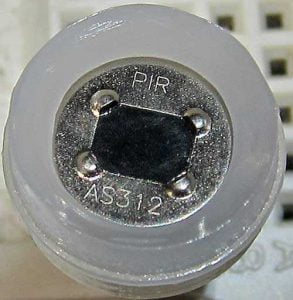AS312 (AM312) Mini PIR module review
In my quest to find a good mini-PIR module, I am now testing this very small (about 25 x 12mm including connector pins) module.
It was described by an Aliexpress seller as an AM312 PIR module (part number: SKU301968) and available for around £1.40 each.

The plastic lens is made in two parts and the top part can easily be removed revealing an AS312 PIR sensor.

A quick web search found it is made by NANYANG SENBA LTD. Their website didn’t provide a datasheet but I eventually found it elsewhere and posted it here:
All of the signal processing is done within the sensor chip and it has a very low power logic output.
It is designed to run at 3 volts and the module provides this using a HT7530-1 low dropout smd regulator.


There is a decoupling capacitor on the regulator input and two on the 3 volt output to the PIR chip.
A 20K Ohm resistor (R2) in series with the logic output limits the available output current so it can only really drive a logic input or a very low gate voltage mosfet.
There is no wrong polarity protection for the power pins. They are marked on the pcb with a very small “+” and “-” symbol. (see the first photo).
The boards I received still had a lot of solder flux and small solder blobs left on them.
The PIR sensor is a very low power device (15μA). I don’t know if the flux residue may affect it’s stability so I sprayed it with flux remover and scrubbed off all the solder debris. This left it looking much cleaner and didn’t affect the plastic lens.
My Initial tests (using a 5V power supply) found it works well enough for my needs. The main considerations are:
- Use a low noise power supply (some extra power supply decoupling capacitors in addition to the those on the module are advisable).
- It needs to be placed away from any convection heat source or window where it may false trigger due to temperature changes.
- It may need a suitable 2.54mm (0.1″) pitch header socket to plug it into a pcb. (The module connector pins can’t easily be unsoldered or bent without possibly damaging it due to the smd parts).

